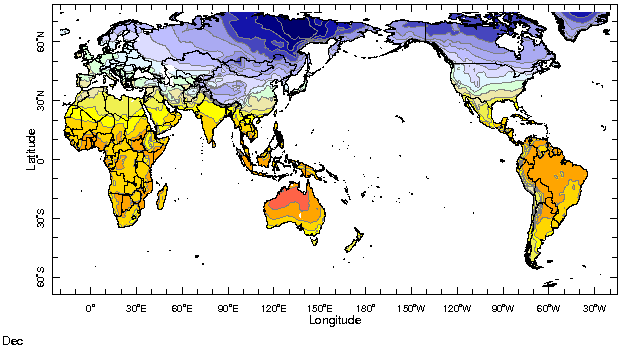|
IRI Climate Digest
January 2006
December Global Climate Summary
Climatological Background
In December, the Northern Hemisphere enters the heart of winter, with strong north-south temperature differences driving the mid-latitude jet stream and storm systems. In the Southern Hemisphere summer is under way, with monsoon systems gaining strength in South America, southern Africa, and Australia.
Monthly Mean Temperature (1961-1990), data from the Climate Research
Unit, University of East Anglia


Monthly Mean Precipitation (1961-1990), data from the Climate Research
Unit, University of East Anglia


Temperatures
Temperatures across the Northern Hemisphere during December were in stark contrast to those seen in November. Nearly all of the northern half of North America was warmer than usual; positive anomalies of 6-10°C were observed across most of western Canada and Alaska. During November, these same areas in Alaska were more than 5°C below normal. Abnormally high temperatures were also seen in western Asia as well as the extreme northern tier of that continent. Central Russia, Mongolia, China and Japan, however, experienced temperatures 1-3°C below-normal during December, but experienced abnormal warmth (i.e., positive anomalies of 1-3°C) during the previous month. Below-average temperatures were observed in parts of western Europe, western Australia, southeastern South America and eastern United States during December. West, Central and East Africa, as well as Eastern Australia, experienced warmer-than-normal conditions.
Temperature Difference from the 1961-1990 mean, with data
from NCEP Climate Prediction Center, CAMS.


Precipitation
The 2005-06 rainy season started in most of Southern Africa during December with parts of Malawi, Mozambique, Zimbabwe, Botswana and Madagascar receiving precipitation amounts well above average, which caused flooding in some areas. Elsewhere in Africa, the short rains ended poorly in portions of East Africa. Below normal precipitation was also observed in western Europe, south-central United States, eastern Australia and southeastern South America. Most of northern South America saw above-average amounts of rainfall during December, as did much of Southeast Asia and the Maritime Continent.
Precipitation Difference from 1979-2000 mean, with data
from NCEP Climate Prediction Center, CAMS-OPI.


Oceanic Conditions
In the December average, below-normal sea surface temperature anomalies in the eastern Equatorial Pacific persisted, and maximum departures as large as -1.5°C migrated westward from November to December. A "horseshoe" pattern of warm temperature anomalies stretching from the eastern South Pacific to the equatorial Western Pacific to the eastern North Pacific became more defined. Ocean temperatures in an area stretching eastward from the vicinity of the Japanese Islands cooled significantly with respect to the mean between November and December. Warm and cold anomalies off the eastern and western coasts of Australia, respectively, persisted and intensified slightly, while significant warming occurred in the south-central Indian Ocean. Warm temperature anomalies continued in the North Atlantic basin, although cool anomalies developed along the coast of the U.S.
Monthly Sea Surface Temperature Difference from the 1971-2000 mean,
with data from the Environmental Modeling Center, NCEP/NOAA.


Contents |
Special |
Impacts |
Climate |
Forecast
|

